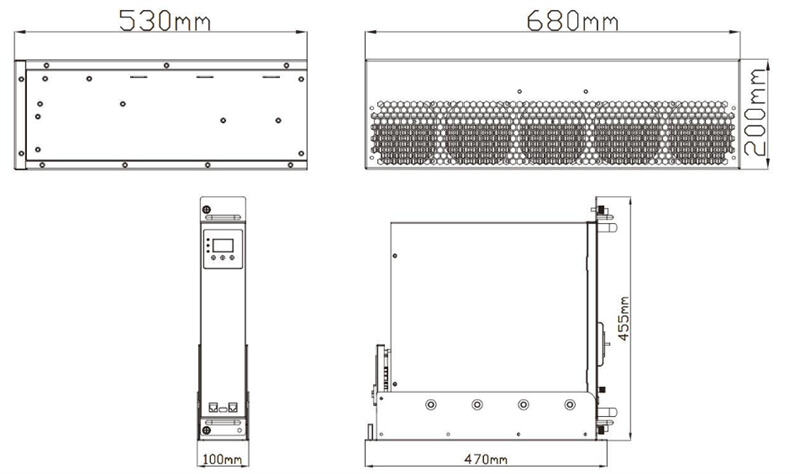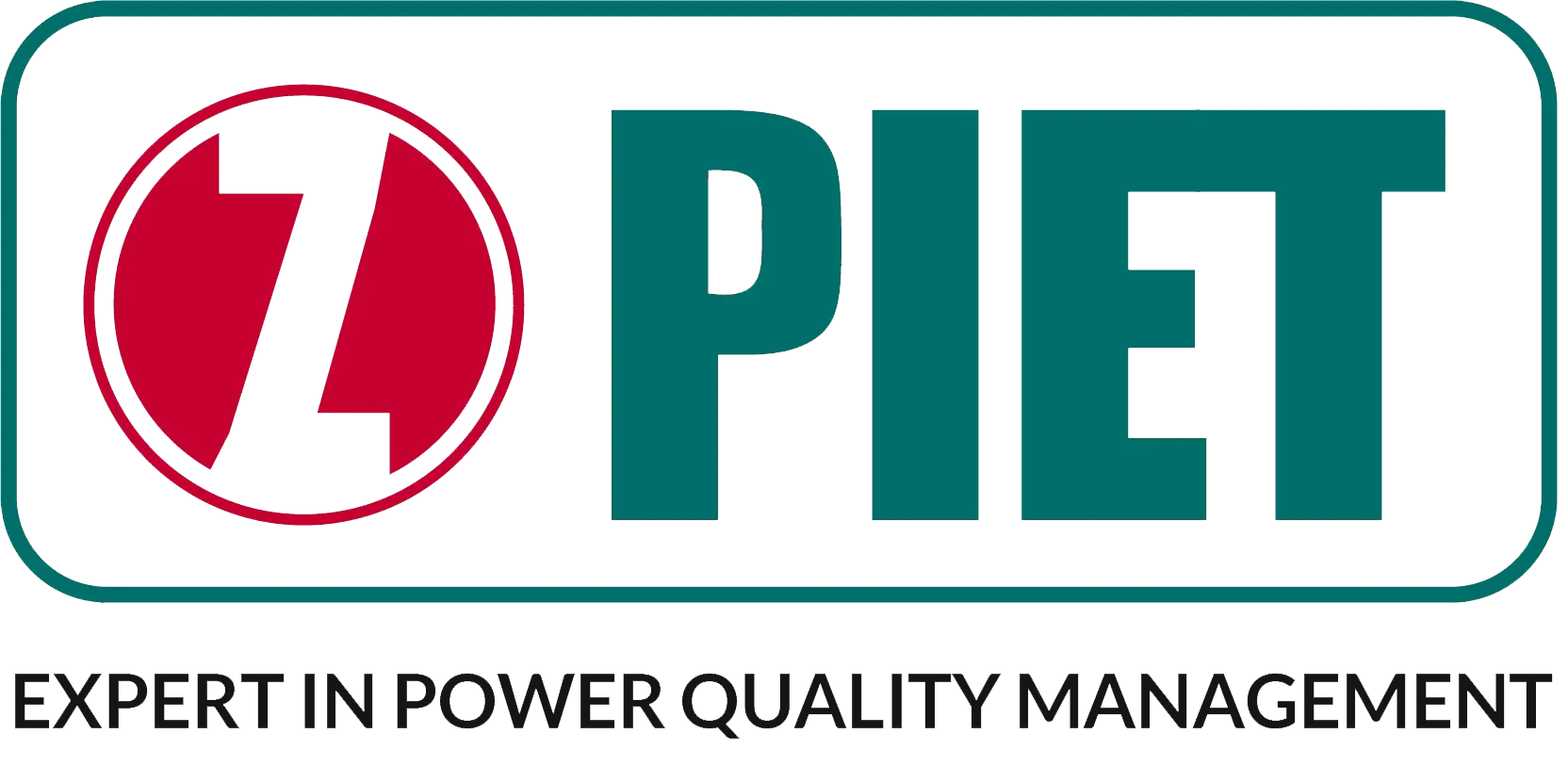With the development and continuous improvement of power electronics technology, high-power turn-off devices IGBT and digital signal processing DSP technology, the Static Var Generator (SVG for short, also known as STATCOM), as the representative of the latest technology in the field of power quality nowadays, It is an important component of Flexible Alternative Current Transmission Systems (FACTS) technology and custom power (CP) technology, representing the development direction of modern reactive power compensation devices.
The PISVG series of low-voltage static reactive power generators adopt flexible AC transmission technology (FACTS), which is a technology for controlling AC transmission formed by integrating power electronics technology, microprocessing and microelectronics technology, and communication technology. The main connotation is to use reliable and high-speed high-power power electronic devices (thyristors, IGBTs, etc.) to replace the mechanical switches currently attached to traditional equipment in the AC system, achieving flexible and rapid control of the AC transmission system, thereby improving the reliability, controllability, operational performance and power quality of the power transmission and distribution system. It is a new type of comprehensive technology.
The product adopts power electronic switch technology, featuring no mechanical wear, a short dynamic response time (in the microsecond range), and rapid control. It can effectively enhance the transient stability of grid voltage, suppress bus voltage flicker, compensate for unbalanced loads, suppress current harmonics in the grid, and effectively prevent system resonance. Ultimately, it achieves PF0.99, a perfect power quality of three-phase balance.
This product complies with the standard DL/T 1216-2019 "Technical Specification for Low-Voltage Static Reactive Power Generation Devices" and has obtained the third-party type test report.

Rated compensation power for a single module: 30kVar / 50kVar / 75kVar / 100kVar / 150kVar
Maximum compensation power for a single cabinet: 500kVar

◆ Fast: Dynamic real-time tracking and compensation, fast response speed, instantaneous response time ≤ 1ms, full response time ≤ 10ms
◆ Smooth: It can continuously adjust reactive power, smoothly output reactive current, and dynamically track the power factor to maintain 0.99
◆ Bidirectional: The output current phase can be adjusted from -90 to 90 degrees, and inductive and capacitive reactive power can be compensated bidirectionally. It is very suitable for long-distance transmission lines with small loads
◆ High efficiency: The compensation capacity is the installation capacity. Under the same compensation effect, the PISVG capacity can be 20%-40% smaller than the capacitor capacity
◆ Stability: The perfect LCR output circuit and software damping algorithm automatically suppress overload, with no resonance risk. Multiple protection functions ensure the safe and reliable operation of the system
◆ Integration: It can compensate for reactive power and harmonic currents below the 25th order, meeting the filtering requirements of the vast majority of power consumption sites, with multiple functions in one machine
◆ Intelligence: Self-diagnosis of faults, historical event recording, RS485 interface + standard MODBUS communication protocol, remote monitoring
Component composition
◆ IGBT high-frequency power power electronic switch
◆ High-quality DC support energy storage system
◆ LCR output module
◆ DSP-A data processing and communication components
◆ DSP-B filter compensation algorithm component
◆ FPGA Pulse and protection logic processing components
◆ Touch LCD display screen, efficient UI interface
|
Working Power Supply |
|
|
Rated Voltage |
AC400V ±15% (AC690V ±15%), three-phase four-wire |
|
Rated Power Consumption |
3% of rated compensation capacity |
|
Rated Frequency |
50±5Hz |
|
Overall Efficiency |
>98% |
|
Performance Indicators |
|
|
Compensation Capacity |
100% rated reactive power |
|
Compensation Range |
Power factor -1~1; full capacitive or full inductive, reactive current output angle -90 degrees -90 degrees; |
|
Instantaneous Response Time |
<1ms <1 millisecond |
|
Full Response Time |
<10ms <10 milliseconds |
|
Switching Frequency |
20KHz |
|
Operating Noise |
<60dB <60 decibels |
|
Mean Time Between Failures |
≥10000 hours |
|
Operating Environment |
|
|
Ambient Temperature |
-10℃~+45℃ -10°C~ +45°C |
|
Storage Temperature |
-40℃~70℃ -40°C~ 70°C |
|
Relative Humidity |
≤95% at 25℃, no condensation |
|
Altitude |
≤2000m, customizable for exceeding standards |
|
Atmospheric Pressure |
79.5~106.0Kpa 79.5 ~ 106.0Kpa |
|
Surrounding Space |
No flammable and explosive media, no conductive dust and corrosive gases |
|
Insulation and Protection |
|
|
Primary and Enclosure |
AC2500V for 1min, no breakdown or flashover |
|
Primary and Secondary |
AC2500V for 1min, no breakdown or flashover |
|
Secondary and Enclosure |
AC2500V for 1min, no breakdown or flashover |
|
Safety Protection Level |
IP30 |
•Design and Selection
Design Principle:
The PISVG static var generator monitors the load current in real-time through an external current transformer (CT), analyzes the reactive component of the load current through internal DSP calculation, and then controls the PWM signal generator to send control signals to the internal IGBT according to the set value, so that the inverter generates the required reactive compensation current, and finally realizes the purpose of dynamic reactive compensation.
Applicable Working Conditions and Occasions:
PISVG has a power factor of 0.99 level reactive compensation function, which can compensate capacitive and inductive loads and three-phase unbalanced loads. The reactive compensation effect is stable and fast, with a dynamic response time of <50us. It is suitable for occasions where reactive power changes frequently. The compensation capacity is equal to the installed capacity, not affected by system voltage dips, does not amplify system harmonics, has no resonance, and can be used in occasions with excessive harmonics.
Application Fields:
|
Industry Type |
Load |
|
Automobile Manufacturing |
Welding machines, carbon dioxide shielded welding, conveying systems, punch presses, welding machines |
|
Internet Data Center |
Switching power supplies, UPS, inverter air conditioners, elevators, lighting |
|
Hospital |
Electronic medical precision equipment, frequency conversion equipment, computer UPS |
|
Modern Architecture |
Switching power supplies, LED, elevators, lighting, inverter air conditioners, energy saving |
|
Theaters and Performance Centers |
Lighting, elevators, air conditioners, screens, LED |
|
Photovoltaics |
Monocrystalline furnaces, slicing machines |
|
Oil Extraction |
AC generator sets, derricks, drill plates, mud pumps |
|
Semiconductor |
Monocrystalline furnaces |
|
Theme Parks and Hotels |
UPS, lighting, elevators, air conditioners |
|
Iron and Steel Smelting |
Blast furnaces, converters, intermediate frequency furnaces, arc furnaces, transmission systems |
|
Papermaking |
Pulpers, superpresses, paper cutters, CNC machine tools, lighting, air conditioners |
|
Subway |
Elevators, lighting, UPS |
|
Sewage Treatment |
Fans, pumps |
|
Garbage Power Generation |
Pumps |
|
Electric Vehicle Charging Stations |
Chargers |
|
Rubber |
Internal mixers, extruders, forming machines, vulcanizing machines |
Calculation of PISVG Reactive Compensation Capacity: The total capacity of reactive compensation is usually determined according to the transformer capacity, and the empirical compensation accounts for 20% to 30% of the transformer capacity.
|
Transformer Capacity (KVA) |
315 |
630 |
800 |
1000 |
1250 |
1600 |
2000 |
2500 |
|
|
PISVG |
Capacity (kvar) |
100 |
200 |
250 |
300 |
400 |
500 |
600 |
750 |
|
Fixing Method |
Cabinet type (standard cabinet dimensions 600×600×2200mm³, 600×800×2200mm³, 800×800×2200mm³) |
||||||||
|
Number of Cabinets |
1 |
1 |
1 |
1 |
1 |
1 |
2 |
2 |
|
1. The above quick configuration is the regular engineering estimation data. In actual use, a small number of users may find that their reactive power demand is much greater than the estimated data. Later, the compensation capacity can be increased according to the actual reactive power demand.
2. The above quick configuration is the recommended capacity required when all PISVG is adopted. For most user projects, 50-100 kvar SVG and harmonic suppression reactive power compensation modules can be used in combination to form a hybrid compensation device. The effect remains the same when the load changes little, which can reduce the capacity of SVG and save costs.
3. If filtering is required, in engineering scenarios where there are no more than 15 low-order harmonic currents and the harmonic voltage content rate is less than 5%, the corresponding compensation capacity should be increased according to the harmonic current value, and the active power filtering function should be enabled to achieve dual excellence in harmonic filtering and reactive power compensation.
4. If filtering is required, in engineering situations where there are more than 15 high-order harmonic currents and the harmonic voltage content rate is greater than 5%, professional PIAPF series active power filter devices should also be configured for harmonic control.

Copyright © Nantong Zhifeng Electric Power Technology Co., Ltd. All Rights Reserved - Privacy Policy - Blog